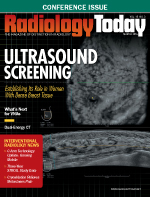 March 2014
March 2014
A Giant Anniversary
By Jim Knaub
Radiology Today
Vol. 15 No. 3 P. 3
Eighty-two-year-old Laura Shaw refused to let a surgeon amputate her left foot despite a nonhealing ulcer and gangrenous toes. Three years later, she died of congestive heart failure. In between came the revolution sparked by Charles T. Dotter, MD.
This year marks the 50th anniversary of the first percutaneous transluminal angioplasty procedure, in which Dotter used a catheter to open a blockage in Shaw’s superficial femoral artery. Her foot ulcer healed, and the vessel was patent two years after the procedure.
You can be sure the anniversary will merit observance at this month’s Society of Interventional Radiology (SIR) meeting in San Diego. The good people at SIR won’t overlook the golden anniversary of the dawn of their specialty.
“It was a disruptive technology. It completely changed how people looked at the treatment of a whole variety of diseases,” says SIR president Scott C. Goodwin, MD. “He’s clearly the father of interventional radiology. He started it all back in January of 1964.”
In this case, characterizing someone as the father of a specialty is not hyperbole. Consider this list of Dotter’s landmarks that Goodwin mentioned when we spoke:
• arterial stenting;
• safety guide wire;
• double-lumen balloon catheter; and
• thrombolysis.
Pretty much everything that has followed down the wire since 1964 is evolutionary change advancing Dotter’s revolutionary change. Consider the ongoing incremental changes in catheters as well as the evolution of stent design and the possibilities that come with coating bare metal stents. Then add the advances in embolization treatments, drug delivery, valve repair, and interventional oncology.
Looking ahead, Goodwin pointed out that while interventional radiology is improving its ability to access more specific and small places in the body, others in the medical field are developing new drug and biologic treatments to deliver to those places. The convergence of those ideas and technologies involving both drug and delivery will lead to treatments that cannot be done today.
If you are one those people who can see so far as to envision those future treatments and are working to achieve them, occasionally take a moment to look down and remember the giant’s shoulders on which you stand. Whether you trace the “shoulders of giants” idea to Sir Isaac Newton’s famous turn of the phrase or to some earlier source is just a matter of attribution. What’s more important is that if you are working in interventional radiology and look down, you should envision the shoulders of Charles Dotter.
Enjoy the issue, and I hope to see many of you at SIR in San Diego. Please stop by booth number XXX for a visit.
jknaub@gvpub.com

